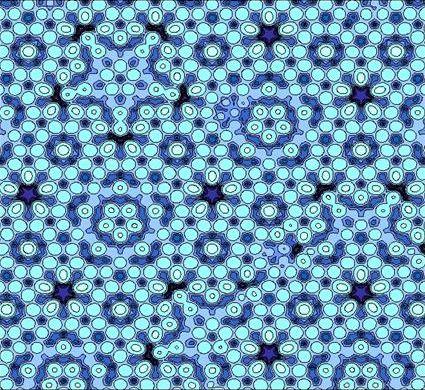The Prize’s Legacy: Dan Shechtman
Since 1984, hundreds of quasicrystals have been discovered. Many, though far from all, involve alloys of aluminum and other elements. Quasiperiodic materials were eventually manufactured not just by using the original rapid solidification method, but also through a wide variety of other techniques, including casting, single-crystal growth, electrodeposition, chemical vapor deposition and physical vapor deposition.

The original quasicrystal that Shechtman discovered was “metastable”: when it was heated to a high enough temperature (350–400 degrees C), it no longer was quasi-periodic and transformed into a new phase. The quasiperiodic structure became periodic through a realignment in the positions of its atoms. This led scientists to wonder briefly whether all quasicrystals would be metastable. But within a few years of the original discovery, scientists, and mainly An Pang Tsai of Japan, found quasicrystals that were stable, meaning that when they were heated up to the melting point, they did not undergo a phase transformation and remained quasiperiodic.
As with any new material, scientists and engineers have investigated quasicrystals for potential applications. One such effort yielded a quasicrystal with very low surface friction, and a company in France began manufacturing a nonstick coating based on it. Shechtman has a pan with this coating in his kitchen, and says it’s better than Teflon, the now-obsolete coating that was highly popular a few decades ago. But because of a reaction with salt, they are no longer in production.
Quasicrystals have also been used in other niche applications such as razor blades. But on the whole, says Boettinger, “there’s no killer application for this material that revolutionized anything.” The revolution has been conceptual, rather than commercial. Cahn placed it in the context of the famous philosopher of science Thomas Kuhn’s scientific revolutions, which overturn a paradigm previously held by the entire scientific community.
“It’s a big thing,” says Lifshitz. “We’re trying to uncover, unfold the way nature works. Crystals are a very common form of matter, and we’ve missed a big chunk of what a crystal might be, just by thinking the only thing we have are these periodic crystals. And Shechtman fixed that.”
Physicists have also sought a general mathematical description of quasiperiodic materials that could sit alongside the long-established description of periodic crystals. So far, the effort has not met with clear success. Unlike the relatively small number of possible periodic crystal structures, there is no limit to the number of possible non-periodic structures, says Mermin.
Quasicrystals have, however, grown into a mature subdiscipline within crystallography, with annual conferences devoted to the topic. Lifshitz says they are valuable not necessarily for their direct applications, but for opening scientists’ minds to new possibilities about how matter can arrange itself. For instance, he and others are studying whether new metamaterials—composite materials built up from simpler structures that can interact with light in ways not found in nature—could be made with quasiperiodic crystals. “The impact [of quasicrystals] is on the way we understand nature,” says Lifshitz.
Shechtman himself spent years defending quasicrystals from their critics. But after he had convinced the science world of their existence, he moved on to other topics. He spent a number of years studying the microscopic structure, and specifically the twinning structure, of diamonds through a method known as chemical vapor deposition, including during a second two-year sabbatical at NIST from 1992 to 1994. Another line of research involved developing magnesium-based alloys for applications such as biodegradable implants to be used in surgery. While he still holds his position at Technion, since 2004, he has also been a professor of materials science at Iowa State University in Ames, Iowa.
In 2014, Shechtman announced a bid to run for president of Israel. He received endorsements from 10 members of the Knesset, Israel’s legislative body, which elects the nation’s president as one of its functions. Physicists have been called upon to become leaders of Israel since Albert Einstein was approached in 1952 to become the nation’s first president, an offer that Einstein declined. Shechtman vied to be the first scientist to become Israel’s president since biophysicist Ephraim Katzir in 1972. But ultimately, he won just one vote in the Knesset election.
Beyond pure science research, Shechtman has developed a highly popular entrepreneurship course at Technion, where he has instructed thousands of budding scientists on how to bridge the gap between academia and industry. This year will be the 30th year he teaches it. Lately, he has focused a lot of his energy on science education and outreach to children, giving lectures and even starring in an Israeli television show called “To be a scientist with Professor Dan.”
“In Israel he is considered a guru on…how to conduct science, how to support science, teach science, how to do public outreach and outreach to industry, how to promote entrepreneurship.”
– Ron Lifshitz, materials scientist at Tel Aviv University in Israel
Additional Sources
Focus: Nobel Prize-Discovery of Quasicrystals. American Physical Society. Web. https://physics.aps.org/story/v28/st14
Nobel Laureate Dan Shechtman: Advice for Young Scientists. American Physical Society. Web. https://www.aps.org/publications/apsnews/201703/shechtman.cfm
Dan Shechtman-Profile and Biography. Iowa State University. Web. http://www.engineering.iastate.edu/directory/?user_page=dans
D. Shechtman-Biographical. Nobelprize.org. Nobel Media AB 2014. Web. http://www.nobelprize.org/nobel_prizes/chemistry/laureates/2011/shechtman-bio.html
D. Shechtman - Nobel Lecture: Quasi-periodic Materials - a Paradigm Shift in Crystallography." Nobelprize.org. Nobel Media AB 2014. Web. http://www.nobelprize.org/nobel_prizes/chemistry/laureates/2011/shechtman-lecture.html
The Nobel Prize in Chemistry 2011 - Popular Information. Nobel Media AB 2014. Web. http://www.nobelprize.org/nobel_prizes/chemistry/laureates/2011/popular.html


